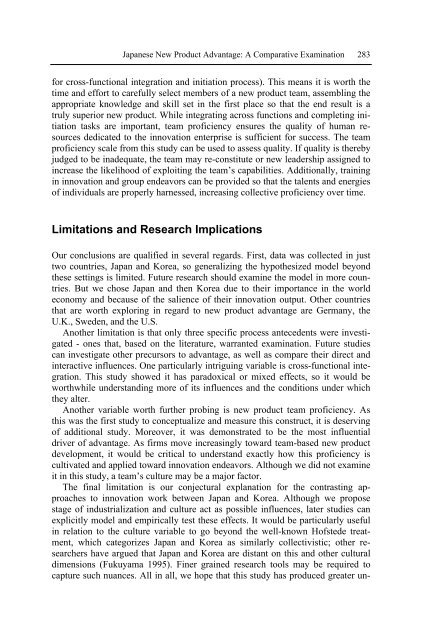Management of Technology and Innovation in Japan
Management of Technology and Innovation in Japan
Management of Technology and Innovation in Japan
You also want an ePaper? Increase the reach of your titles
YUMPU automatically turns print PDFs into web optimized ePapers that Google loves.
<strong>Japan</strong>ese New Product Advantage: A Comparative Exam<strong>in</strong>ation 283<br />
for cross-functional <strong>in</strong>tegration <strong>and</strong> <strong>in</strong>itiation process). This means it is worth the<br />
time <strong>and</strong> effort to carefully select members <strong>of</strong> a new product team, assembl<strong>in</strong>g the<br />
appropriate knowledge <strong>and</strong> skill set <strong>in</strong> the first place so that the end result is a<br />
truly superior new product. While <strong>in</strong>tegrat<strong>in</strong>g across functions <strong>and</strong> complet<strong>in</strong>g <strong>in</strong>itiation<br />
tasks are important, team pr<strong>of</strong>iciency ensures the quality <strong>of</strong> human resources<br />
dedicated to the <strong>in</strong>novation enterprise is sufficient for success. The team<br />
pr<strong>of</strong>iciency scale from this study can be used to assess quality. If quality is thereby<br />
judged to be <strong>in</strong>adequate, the team may re-constitute or new leadership assigned to<br />
<strong>in</strong>crease the likelihood <strong>of</strong> exploit<strong>in</strong>g the team’s capabilities. Additionally, tra<strong>in</strong><strong>in</strong>g<br />
<strong>in</strong> <strong>in</strong>novation <strong>and</strong> group endeavors can be provided so that the talents <strong>and</strong> energies<br />
<strong>of</strong> <strong>in</strong>dividuals are properly harnessed, <strong>in</strong>creas<strong>in</strong>g collective pr<strong>of</strong>iciency over time.<br />
Limitations <strong>and</strong> Research Implications<br />
Our conclusions are qualified <strong>in</strong> several regards. First, data was collected <strong>in</strong> just<br />
two countries, <strong>Japan</strong> <strong>and</strong> Korea, so generaliz<strong>in</strong>g the hypothesized model beyond<br />
these sett<strong>in</strong>gs is limited. Future research should exam<strong>in</strong>e the model <strong>in</strong> more countries.<br />
But we chose <strong>Japan</strong> <strong>and</strong> then Korea due to their importance <strong>in</strong> the world<br />
economy <strong>and</strong> because <strong>of</strong> the salience <strong>of</strong> their <strong>in</strong>novation output. Other countries<br />
that are worth explor<strong>in</strong>g <strong>in</strong> regard to new product advantage are Germany, the<br />
U.K., Sweden, <strong>and</strong> the U.S.<br />
Another limitation is that only three specific process antecedents were <strong>in</strong>vestigated<br />
- ones that, based on the literature, warranted exam<strong>in</strong>ation. Future studies<br />
can <strong>in</strong>vestigate other precursors to advantage, as well as compare their direct <strong>and</strong><br />
<strong>in</strong>teractive <strong>in</strong>fluences. One particularly <strong>in</strong>trigu<strong>in</strong>g variable is cross-functional <strong>in</strong>tegration.<br />
This study showed it has paradoxical or mixed effects, so it would be<br />
worthwhile underst<strong>and</strong><strong>in</strong>g more <strong>of</strong> its <strong>in</strong>fluences <strong>and</strong> the conditions under which<br />
they alter.<br />
Another variable worth further prob<strong>in</strong>g is new product team pr<strong>of</strong>iciency. As<br />
this was the first study to conceptualize <strong>and</strong> measure this construct, it is deserv<strong>in</strong>g<br />
<strong>of</strong> additional study. Moreover, it was demonstrated to be the most <strong>in</strong>fluential<br />
driver <strong>of</strong> advantage. As firms move <strong>in</strong>creas<strong>in</strong>gly toward team-based new product<br />
development, it would be critical to underst<strong>and</strong> exactly how this pr<strong>of</strong>iciency is<br />
cultivated <strong>and</strong> applied toward <strong>in</strong>novation endeavors. Although we did not exam<strong>in</strong>e<br />
it <strong>in</strong> this study, a team’s culture may be a major factor.<br />
The f<strong>in</strong>al limitation is our conjectural explanation for the contrast<strong>in</strong>g approaches<br />
to <strong>in</strong>novation work between <strong>Japan</strong> <strong>and</strong> Korea. Although we propose<br />
stage <strong>of</strong> <strong>in</strong>dustrialization <strong>and</strong> culture act as possible <strong>in</strong>fluences, later studies can<br />
explicitly model <strong>and</strong> empirically test these effects. It would be particularly useful<br />
<strong>in</strong> relation to the culture variable to go beyond the well-known H<strong>of</strong>stede treatment,<br />
which categorizes <strong>Japan</strong> <strong>and</strong> Korea as similarly collectivistic; other researchers<br />
have argued that <strong>Japan</strong> <strong>and</strong> Korea are distant on this <strong>and</strong> other cultural<br />
dimensions (Fukuyama 1995). F<strong>in</strong>er gra<strong>in</strong>ed research tools may be required to<br />
capture such nuances. All <strong>in</strong> all, we hope that this study has produced greater un-


